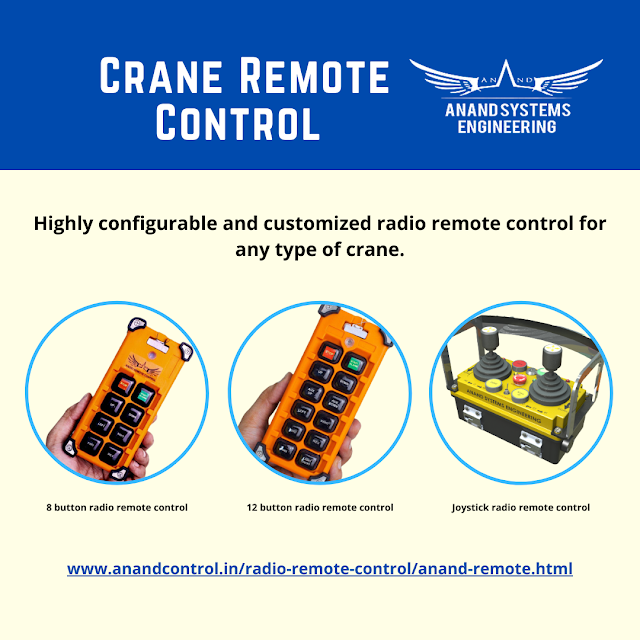Wireless Radio Remote Control for Your Crane
The industrial crane is also known as an overhead crane. These cranes are work overhead at height. EOT crane is another type of crane which are widely used in industrial application. It has different types such as single girder eot crane and double girder eot crane. To operate a crane using the traditional method is quite risky. To control different types of cranes wirelessly, Anand radio remote control is the best option in an overall crane remote control.
Anand radio remote control can move in different directions such as up, down, forward, reverse, left, right, and on, off. It also has the ability to long travel and cross travel. A radio remote control for an industrial crane has available in a transmitter and a receiver.Why Crane Remote
Control?
The radio remote control
completely works on wireless technology, and therefore the operator can operate
the crane from a long distance or in a coverage area. The device can send and
receive the signal from a distance of up to 200 meters. The main advantage of
the crane radio remote control is that it does not have cable, so the operator
does not need to stay near the crane. Another feature of the device is that it
automatically adjusts performance. This means that if the distance is less than
the device it consumes little power and if the device is far from the crane,
adjust the power as needed.
How does wireless crane
remote control work?
Electromagnetic waves
that oscillate in the frequency range of 10 kHz to 300 GHz are known as radio
waves and microwaves. A hoist
crane wireless remote control uses radio wave frequency. The radio
remote control of the crane uses transmitters and receivers to send and receive
the signals.
A push button on the
radio remote control creates transmitting data for the receiver. The
transmitter transmits the encoded data to the receiver. This encoded signal is sent from the
transmitter which is controlled by the operator. And this signal is received by
the receiver that is connected to the crane control panel. When the signal
reaches the receiver, the receiver decodes or decrypted the transmitted signal
and assigns that data to relays. These relays activate the switches according
to the assigned relay on eot crane control panel.
The communication
between Anand transmitter and Anand receiver takes place more than 10 times per second. The transmitter side
continuously monitors different factors of communication link like the number
of successful transmission attempts, received signal strength, link quality
indicator, lost packets, etc.
Anand Transmitter and
Receiver
The transmitter is the
portable remote control. Each button activates the remote control of the EOT
crane and generates a collection of information for the crane receiver. This
information is first encrypted and then transmitted to the recipient.
Anand transmitter and
receiver are highly customizable and configurable. With insurmountable safety
and reliability, you can configure your radio remote control according to your
crane. It is not only customizable but also reliable.
Anand Systems uses software programmed to have a custom range
of 10 to 200 meters, depending on user requirements, without the need to change hardware. Anand eot
crane remote controls were designed from the ground up to be able
to transmit signals over long distances with as little power as possible.
Why Anand Radio Remote
Control for the crane?
Anand Systems
Engineering is an Industrial Crane Remote Control Manufacturer. Anand systems
use advanced technology and software for crane control devices for crane remote
control. Anand radio remote uses the 2.4 GHz frequency band for worldwide use.
Anand remote controls are designed as close to the ground as possible to
transmit alarms over long distances on the ground.
Anand Remote Control Crane is quite optimized and specially developed for your eot crane. We offer a large selection of remote crane controls to achieve the goals: Reduce production downtime with an exceptionally high level of reliability and increase safety through assembly equipment and the best possible standard of protection.




Comments
Post a Comment